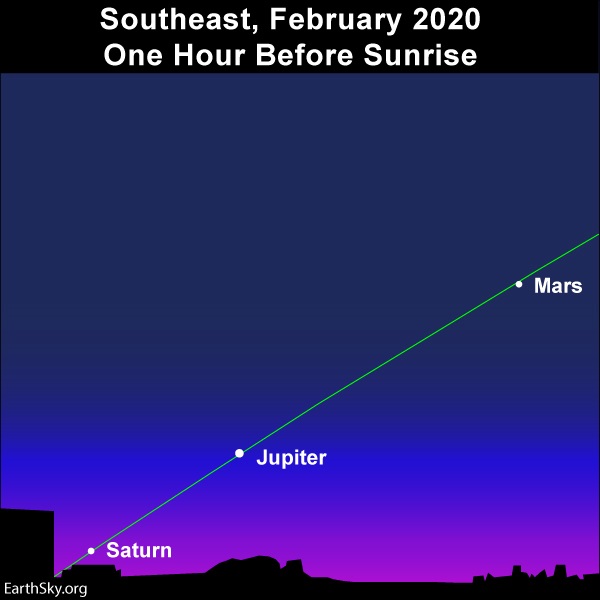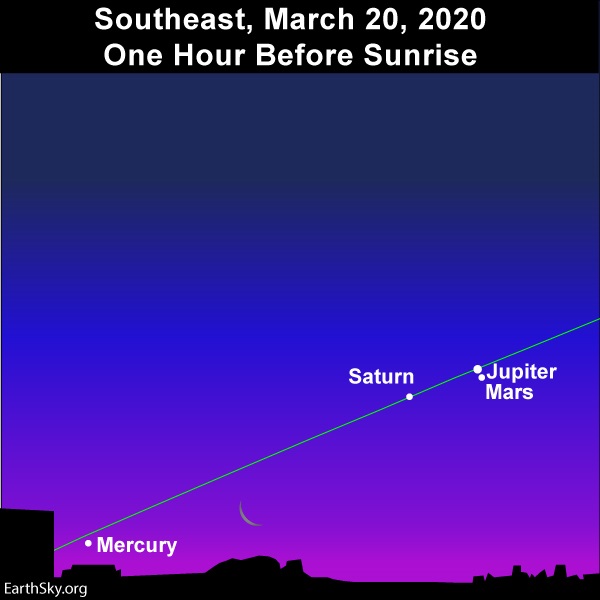
Click the name of a planet to learn more about its visibility in February 2020:
Evening planets: Venus and Mercury (until late February)
Morning planets: Mars, Jupiter and Saturn
Try Stellarium for a precise view from your location.
Click here for recommended almanacs; they can help you know when the planets rise and set in your sky.

The dazzling object in the west after sunset throughout February 2020 is Venus. Use Venus to find Mercury near the sunset point on the horizon about an hour after sunset, for the first 2 weeks of February. Binoculars will help in finding Mercury. Read more here or here.

There are 3 planets in the east before sunrise. Draw an imaginary line from Mars through Jupiter to locate Saturn near the sunrise point on the horizon. Read more.

On February 16 and 17, 2020, the lit side of the waning crescent moon will point to the planets Mars, Jupiter and Saturn. Read more.

The waning crescent moon will meet up with Jupiter on or near February 19 and with Saturn on or near February 20. Read more.
Venus – the brightest planet – blazes mightily in the western sky after sunset. In fact, it’s the only bright planet to light up these February evenings all month long, although – from northerly latitudes – you might glimpse Mercury at late dusk, beneath Venus, for a week or two. Given clear skies, it’ll be hard to miss Venus, the third-brightest celestial body to light up the heavens, after the sun and moon. Some sharp-sighted people can even see Venus in a daytime sky.
Venus is in good view in the evening sky from around the world, although it stays out longer after dark at more northerly latitudes. At mid-northern latitudes, Venus sets about 3 1/3 hours after sunset at the beginning of the month, and about 3 3/4 hours after sundown by the month’s end. At temperate latitudes in the Southern Hemisphere, Venus sets roughly 2 hours after sunset all month long.
Look for the moon in the vicinity of Venus for several days, centered on or near February 27, 2020.
Mercury puts on a good evening showing at northerly latitudes. Look first for dazzling Venus and then seek for Mercury near the sunset point on the horizon as dusk slides into darkness.
The Northern Hemisphere has the advantage for catching Mercury. At the beginning of the month, at mid-northern latitudes, Mercury sets about 1 1/4 hours after sunset. At Mercury’s greatest elongation on February 10, 2020, from mid-northern latitudes, Mercury sets about 1 1/2 hours after the sun. From temperate latitudes in the Southern Hemisphere, Mercury sets about 3/4 hour after sunset at the beginning of the month. At its greatest elongation on February 10, Mercury still sets about 3/4 hour after the sun.
Although this evening apparition of Mercury favors the Northern Hemisphere, the Southern Hemisphere will enjoy the advantage when Mercury becomes a morning object in March and April 2020. Mercury officially transitions out of the evening sky and into the morning sky on February 26, 2020.
Mars is the first bright planet to rise into the morning sky throughout February 2020, followed by Jupiter and then Saturn.
At mid-northern latitudes, Mars rises about 3 hours before the sun throughout February. At temperate latitudes in the Southern Hemisphere, Mars comes up about 4 hours before sunrise in early February, and nearly 5 hours before the sun at the month’s end.
Let the waning crescent moon help guide your eye to Mars for several mornings, starting on or near February 16. From the United States and much of North America, you can watch the moon occult (cover over) Mars on the morning of February 18, 2020.
Read more: Head’s up! Lunar occultation of Mars February 18
Mars is now in that part of its cycle with respect to Earth in which it’ll hover in our predawn sky for some months, appearing only modestly-bright. Mars was in conjunction with the sun – or almost behind the sun as seen from Earth – on September 2, 2019. And now it remains far across the solar system from us, with Earth speeding around in its orbit, trying to catch Mars again. But it’ll be some months before we catch Mars, the swiftest-moving superior planet.
Mars alternates years appearing bright in our sky, or faint. 2019 was a dull year, but 2020 will be an exciting one, for Mars! The excitement will build slowly, though, with Mars sitting low in the east as the year begins. January, February, March 2020 … you’ll still find Mars doing nothing much, rather low in the east before dawn. Earth will still be far across the solar system from Mars, but we’ll be rushing along in our smaller, faster orbit, trying to catch up with Mars. As northern summer 2020 approaches, Mars will begin to change. It’ll begin to brighten more dramatically as, finally, Earth begins to catch up to Mars. The red planet will appear brightest in our sky – very bright indeed and fiery red – around the time of its opposition on October 13, 2020.
Jupiter – the second-brightest planet – is a morning planet all month long. Before sunrise on or near February 19, let the slender waning crescent moon help guide you to Jupiter.
At mid-northern latitudes, Jupiter rises about 1 1/2 hours before the sun in early February, and about 2 1/2 hours before by the month’s end. At temperate latitudes in the Southern Hemisphere, Jupiter rises about 2 1/4 hours before the sun in early February, and about 4 hours before the sun by the month’s end.
Watch for Jupiter to become quite prominent in the morning sky throughout February 2020. On March 20, 2020, Jupiter will catch up with Mars (or, actually, it’ll be Mars that’s catching up with Jupiter on our sky’s dome), to display a dazzling planetary conjunction in the predawn sky.

In 2020, the planets Mars and Jupiter will be in conjunction on the March 20 equinox.
Saturn is more easily viewed from the Southern Hemisphere. From temperate latitudes in the Northern Hemisphere, Saturn sits deeply in the glare of the sunrise in early February, and you may need binoculars to see it in the first week or two or February. The trick to locating Saturn, in either the Northern or Southern Hemisphere, is to find Mars and Jupiter first. Once you’ve done that, draw an imaginary line from Mars through Jupiter to locate Saturn near the horizon.
From mid-northern latitudes, Saturn rises about 3/4 hour before the sun at the beginning of the month, and about 2 hours before sunrise by the month’s end. From temperate latitudes in the Southern Hemisphere, Saturn rises about 1 1/4 hours before sunrise in early February and about 3 1/3 hours before sunrise by the month’s end.
Watch for the waning crescent moon to swing close to Saturn on or near February 20.
What do we mean by bright planet? By bright planet, we mean any solar system planet that is easily visible without an optical aid and that has been watched by our ancestors since time immemorial. In their outward order from the sun, the five bright planets are Mercury, Venus, Mars, Jupiter and Saturn. These planets actually do appear bright in our sky. They are typically as bright as – or brighter than – the brightest stars. Plus, these relatively nearby worlds tend to shine with a steadier light than the distant, twinkling stars. You can spot them, and come to know them as faithful friends, if you try.
Bottom line: In February 2020, Venus lights up the west after sunset, with Mercury beneath Venus at dusk for a few weeks. Before sunrise, you’ll find a string of planets in the east: Mars at top, Saturn at bottom, and very bright Jupiter in between.
Don’t miss anything. Subscribe to EarthSky News by email
Visit EarthSky’s Best Places to Stargaze, and recommend a place we can all enjoy.
Help EarthSky keep going! Donate now.
Post your planet photos at EarthSky Community Photos
from EarthSky https://ift.tt/1YD00CF

Click the name of a planet to learn more about its visibility in February 2020:
Evening planets: Venus and Mercury (until late February)
Morning planets: Mars, Jupiter and Saturn
Try Stellarium for a precise view from your location.
Click here for recommended almanacs; they can help you know when the planets rise and set in your sky.

The dazzling object in the west after sunset throughout February 2020 is Venus. Use Venus to find Mercury near the sunset point on the horizon about an hour after sunset, for the first 2 weeks of February. Binoculars will help in finding Mercury. Read more here or here.

There are 3 planets in the east before sunrise. Draw an imaginary line from Mars through Jupiter to locate Saturn near the sunrise point on the horizon. Read more.

On February 16 and 17, 2020, the lit side of the waning crescent moon will point to the planets Mars, Jupiter and Saturn. Read more.

The waning crescent moon will meet up with Jupiter on or near February 19 and with Saturn on or near February 20. Read more.
Venus – the brightest planet – blazes mightily in the western sky after sunset. In fact, it’s the only bright planet to light up these February evenings all month long, although – from northerly latitudes – you might glimpse Mercury at late dusk, beneath Venus, for a week or two. Given clear skies, it’ll be hard to miss Venus, the third-brightest celestial body to light up the heavens, after the sun and moon. Some sharp-sighted people can even see Venus in a daytime sky.
Venus is in good view in the evening sky from around the world, although it stays out longer after dark at more northerly latitudes. At mid-northern latitudes, Venus sets about 3 1/3 hours after sunset at the beginning of the month, and about 3 3/4 hours after sundown by the month’s end. At temperate latitudes in the Southern Hemisphere, Venus sets roughly 2 hours after sunset all month long.
Look for the moon in the vicinity of Venus for several days, centered on or near February 27, 2020.
Mercury puts on a good evening showing at northerly latitudes. Look first for dazzling Venus and then seek for Mercury near the sunset point on the horizon as dusk slides into darkness.
The Northern Hemisphere has the advantage for catching Mercury. At the beginning of the month, at mid-northern latitudes, Mercury sets about 1 1/4 hours after sunset. At Mercury’s greatest elongation on February 10, 2020, from mid-northern latitudes, Mercury sets about 1 1/2 hours after the sun. From temperate latitudes in the Southern Hemisphere, Mercury sets about 3/4 hour after sunset at the beginning of the month. At its greatest elongation on February 10, Mercury still sets about 3/4 hour after the sun.
Although this evening apparition of Mercury favors the Northern Hemisphere, the Southern Hemisphere will enjoy the advantage when Mercury becomes a morning object in March and April 2020. Mercury officially transitions out of the evening sky and into the morning sky on February 26, 2020.
Mars is the first bright planet to rise into the morning sky throughout February 2020, followed by Jupiter and then Saturn.
At mid-northern latitudes, Mars rises about 3 hours before the sun throughout February. At temperate latitudes in the Southern Hemisphere, Mars comes up about 4 hours before sunrise in early February, and nearly 5 hours before the sun at the month’s end.
Let the waning crescent moon help guide your eye to Mars for several mornings, starting on or near February 16. From the United States and much of North America, you can watch the moon occult (cover over) Mars on the morning of February 18, 2020.
Read more: Head’s up! Lunar occultation of Mars February 18
Mars is now in that part of its cycle with respect to Earth in which it’ll hover in our predawn sky for some months, appearing only modestly-bright. Mars was in conjunction with the sun – or almost behind the sun as seen from Earth – on September 2, 2019. And now it remains far across the solar system from us, with Earth speeding around in its orbit, trying to catch Mars again. But it’ll be some months before we catch Mars, the swiftest-moving superior planet.
Mars alternates years appearing bright in our sky, or faint. 2019 was a dull year, but 2020 will be an exciting one, for Mars! The excitement will build slowly, though, with Mars sitting low in the east as the year begins. January, February, March 2020 … you’ll still find Mars doing nothing much, rather low in the east before dawn. Earth will still be far across the solar system from Mars, but we’ll be rushing along in our smaller, faster orbit, trying to catch up with Mars. As northern summer 2020 approaches, Mars will begin to change. It’ll begin to brighten more dramatically as, finally, Earth begins to catch up to Mars. The red planet will appear brightest in our sky – very bright indeed and fiery red – around the time of its opposition on October 13, 2020.
Jupiter – the second-brightest planet – is a morning planet all month long. Before sunrise on or near February 19, let the slender waning crescent moon help guide you to Jupiter.
At mid-northern latitudes, Jupiter rises about 1 1/2 hours before the sun in early February, and about 2 1/2 hours before by the month’s end. At temperate latitudes in the Southern Hemisphere, Jupiter rises about 2 1/4 hours before the sun in early February, and about 4 hours before the sun by the month’s end.
Watch for Jupiter to become quite prominent in the morning sky throughout February 2020. On March 20, 2020, Jupiter will catch up with Mars (or, actually, it’ll be Mars that’s catching up with Jupiter on our sky’s dome), to display a dazzling planetary conjunction in the predawn sky.

In 2020, the planets Mars and Jupiter will be in conjunction on the March 20 equinox.
Saturn is more easily viewed from the Southern Hemisphere. From temperate latitudes in the Northern Hemisphere, Saturn sits deeply in the glare of the sunrise in early February, and you may need binoculars to see it in the first week or two or February. The trick to locating Saturn, in either the Northern or Southern Hemisphere, is to find Mars and Jupiter first. Once you’ve done that, draw an imaginary line from Mars through Jupiter to locate Saturn near the horizon.
From mid-northern latitudes, Saturn rises about 3/4 hour before the sun at the beginning of the month, and about 2 hours before sunrise by the month’s end. From temperate latitudes in the Southern Hemisphere, Saturn rises about 1 1/4 hours before sunrise in early February and about 3 1/3 hours before sunrise by the month’s end.
Watch for the waning crescent moon to swing close to Saturn on or near February 20.
What do we mean by bright planet? By bright planet, we mean any solar system planet that is easily visible without an optical aid and that has been watched by our ancestors since time immemorial. In their outward order from the sun, the five bright planets are Mercury, Venus, Mars, Jupiter and Saturn. These planets actually do appear bright in our sky. They are typically as bright as – or brighter than – the brightest stars. Plus, these relatively nearby worlds tend to shine with a steadier light than the distant, twinkling stars. You can spot them, and come to know them as faithful friends, if you try.
Bottom line: In February 2020, Venus lights up the west after sunset, with Mercury beneath Venus at dusk for a few weeks. Before sunrise, you’ll find a string of planets in the east: Mars at top, Saturn at bottom, and very bright Jupiter in between.
Don’t miss anything. Subscribe to EarthSky News by email
Visit EarthSky’s Best Places to Stargaze, and recommend a place we can all enjoy.
Help EarthSky keep going! Donate now.
Post your planet photos at EarthSky Community Photos
from EarthSky https://ift.tt/1YD00CF


Aucun commentaire:
Enregistrer un commentaire